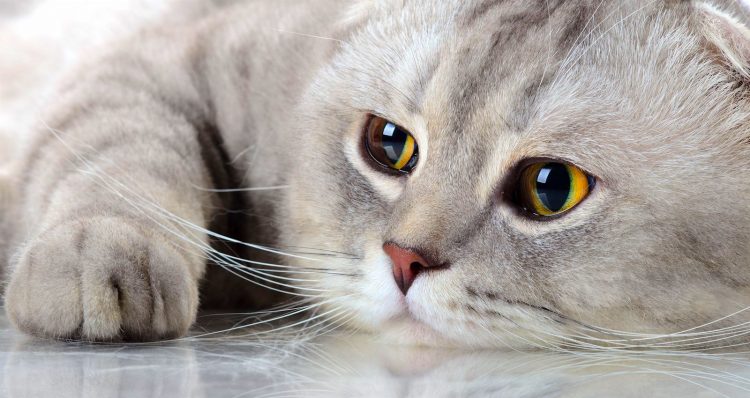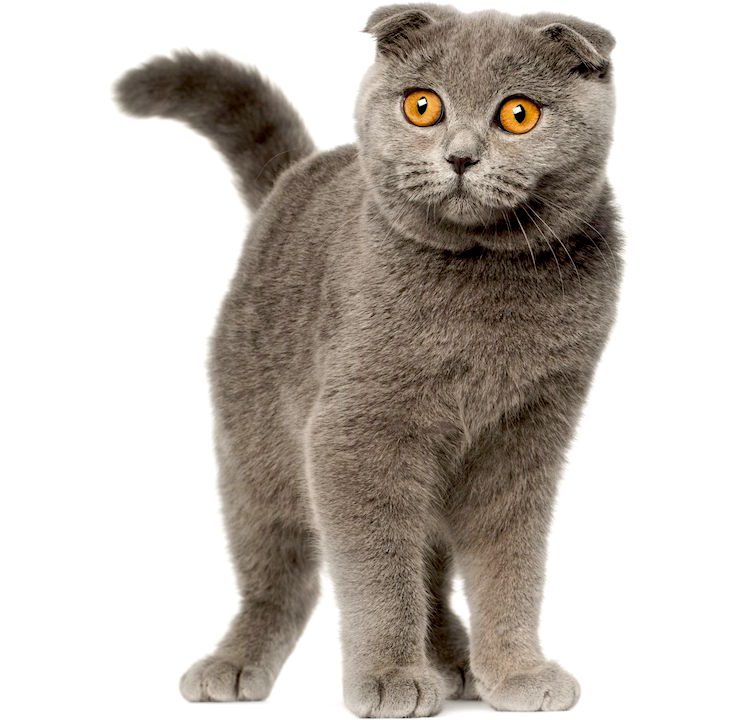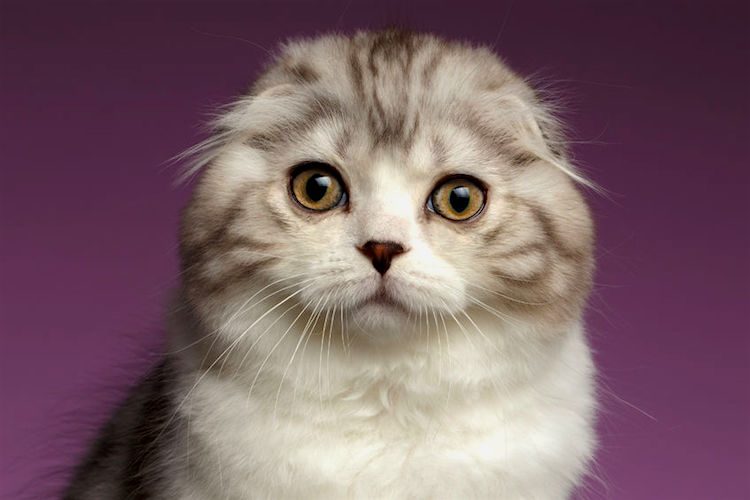
1. Key Characteristics
- Weight: 6–9 pounds for females, 9–13 pounds for males
- Life Expectancy: 15 years
The Scottish Fold is characterized by their unique appearance.
They display surprisingly round features:
- A round face, emphasized by flat ears
- Large, circular eyes
- A short snout (compared to other cat breeds)
- A round body structure with short to medium legs
The distinctive “folded” ears face forward and down toward the face. This fold is caused by a naturally occurring dominant-gene mutation that creates a crease in the cat’s ear cartilage.
Because of recent breeding strategies, some Scottish Folds express the “munchkin” gene — a naturally occurring genetic mutation that causes shortened forelegs and hind legs. However, some consider this to be a controversial breeding practice.
Scottish Folds can be found with long or short hair and in a variety of fur colors and patterns.
2. Where They Came From
The first Scottish Fold, Susie, was reportedly found roaming a farm in Perthshire, Scotland, around 1961.
William Ross took one of her kittens that also shared her folded ear trait and registered the breed with the Governing Council of the Cat Fancy (GCCF) in 1966. Following the registration, Ross partnered with Pat Turner, a geneticist, to discover that a dominant gene caused the trait.
Because of issues with ear infections, deafness and mites, along with deformed limbs and tails, the Scottish Fold was sent to America and crossed with both British and American Shorthairs.
After elimination of these genetic abnormalities, the Scottish Fold was allowed Cat Fanciers’ Association (CFA) registration status in 1974.

3. How Friendly Are They?
Laid-back by nature, Scottish Folds are playful, love attention and prefer to sit near their companions.
They may become excessively timid or mercurial if deprived of attention. They are incredibly loyal and will establish strong bonds with one or more people in a household — regularly following the chosen person from room to room, waiting for recognition or a friendly pat.
Overall, Scottish Folds are famed for their highly adaptive and even-keeled attitudes, making it easy to introduce them to new pets, people and settings.
They are a great pet for children but do not enjoy roughhousing.

Exercise Needs
LOW: Scottish Folds will live as sedentary indoor cats if given the opportunity, but if they’re allowed outdoors, they will gladly spend time roaming and hunting in the yard and neighborhood. After all, their ancestors were farm cats.
If a Scottish Fold is left without exercise stimulation, the lackadaisical demeanor may enable obesity.
Was YOUR Pet Food Recalled?
Check Now: Blue Buffalo • Science Diet • Purina • Wellness • 4health • Canine Carry Outs • Friskies • Taste of the Wild • See 200+ more brands…

To prevent excess weight gain, initiate regular play and provide a healthy diet. Buying cat toys or dangling a piece of string should do the trick, or consider bringing more than one cat into your household.
Grooming Needs
MEDIUM: Grooming requirements vary depending on hair type.
Shorthaired Scottish Folds require weekly brushing, whereas their longhaired counterparts need daily brushing. The fur of longhaired Scottish Folds produces uncomfortable mats more readily than that of their shorthaired counterparts.
If these cats are allowed outdoors, they will likely shed more during spring and fall months and will need more frequent brushing. Indoor cats tend to shed evenly year round, so maintaining a consistent grooming schedule will suffice. Professionals recommend using a quality steel comb to remove hair and prevent mats.
Maintain the nails regularly by clipping the nails every 1–2 weeks, and clean the teeth more often than that.
Health Problems
MEDIUM: Like other breeds with barnyard ancestors, the Scottish Fold is a resilient feline. Nevertheless, they are not without possible genetic abnormalities.
It is considered an unethical breeding practice to mate folded-eared pairs. Combined, the dominant gene that produces folded ears may cause a degenerative joint disease, affecting the spine, hind legs and tail. Visible signs include thicker tail bones or spines, limited mobility, sensitivity to touch and rigid movements.
To avoid joint degeneration, breeders are encouraged to mate folded-eared Scottish Folds with straight-eared Scottish Folds.
Check out these kitty antics:

5. Where to Adopt One
Check local shelters for Scottish Folds in need of a new home. If you’re uncertain about how to find reputable shelters, start by visiting Petful’s adoption page.
Kitten mills do exist, so please read our kitten mill article and familiarize yourself with our puppy mill red flags (they apply to kittens, too).


